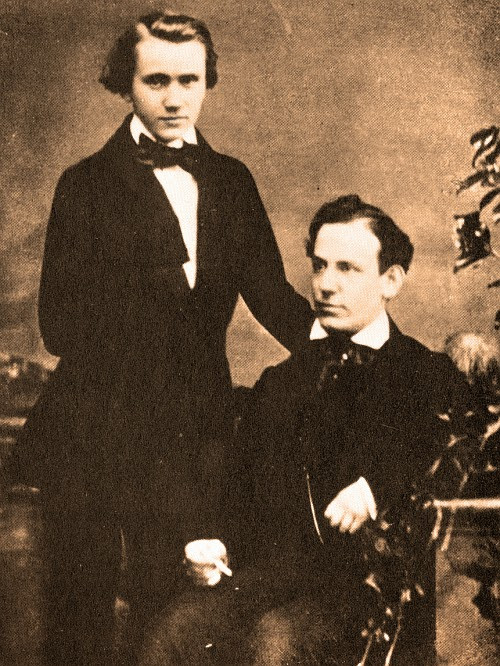Perhaps one of Johannes Brahms’ most universally recognized compositions, the Hungarian Dances stand as a vibrant collection of 21 pieces deeply inspired by the rich tapestry of Hungarian folk music. This diverse genre encapsulates the auditory histories of Hungarians and Hungarian minorities across regions encompassing modern-day Poland, Czech Republic, Slovakia, Slovenia, Moravia, Croatia, and other neighboring nations. Initially conceived for piano, these captivating dances were later skillfully arranged for full orchestra, both by Brahms himself and other admiring composers. You might find yourself humming along to a tune you already know…
 Humorous animated image of a cat 'playing' piano, illustrating the playful nature of Brahms' Hungarian Dances.
Humorous animated image of a cat 'playing' piano, illustrating the playful nature of Brahms' Hungarian Dances.
The 19th-Century Craze for Hungarian Sounds
Brahms was not alone in his profound musical homage to Hungary. The 19th century witnessed a significant wave of composers drawing inspiration from these Eastern European sounds, a movement ignited by Franz Liszt’s celebrated 19 Hungarian Rhapsodies. Brahms’ own foray into this captivating subgenre of classical music was fueled by a couple of key trends. Firstly, piano compositions designed for four hands—requiring two players to perform side-by-side in a dazzling display of dexterity—were reaching the zenith of their popularity. Secondly, there was a burgeoning demand within European taverns and social gatherings for compositions that echoed the vibrant musical traditions of newly immigrated minority cultures.
A Serendipitous Friendship and Musical Awakening
 Historical photograph of Johannes Brahms and Ede Reményi, the Hungarian violinist who inspired Brahms' Hungarian Dances.
Historical photograph of Johannes Brahms and Ede Reményi, the Hungarian violinist who inspired Brahms' Hungarian Dances.
The wellspring of Brahms’ inspiration for his Hungarian Dances can be traced back to an encounter years prior with the Hungarian violinist Ede Reményi. Interestingly, Reményi and the renowned violinist Joseph Joachim (for whom Brahms would later compose his Double Concerto for Violin and Cello) shared the same teacher. A few years after first witnessing Reményi’s captivating performances, a young, 20-year-old Brahms took on the role of his accompanying pianist. This pivotal experience saw Brahms touring extensively with Reményi, immersing himself in and absorbing the violinist’s native musical heritage firsthand.
This authentic immersion in Hungarian folk music provided Brahms with the foundation to embark on his own compositional journey within the genre. Setting quill to manuscript, he began to craft pieces in this distinctive style. While only Nos. 11, 14, and 16 of the 21 dances are definitively attributed as entirely original Brahms creations, the complete set has become one of his most beloved and frequently performed works. Within his Hungarian Dances, Brahms masterfully captured the buoyant and exhilarating essence of the csárdás and verbunkos, traditional Hungarian folk dances renowned for their dramatic shifts in tempo, lively rhythms, and virtuosic, whirling passages.
Delving into Csárdás and Verbunkos
The term csárdás is actually an umbrella term encompassing a diverse array of Hungarian folk dances. These dances, each with subtle regional variations in name, structure, and performance, are found across different ethnic areas of Hungary. Csárdás performances involve both male and female dancers, with the latter often adorned in traditional wide skirts that create a striking flared silhouette as they twirl, a visual element clearly seen at the 3:18 mark in the video previously mentioned in the original article.
The verbunkos, the older of the two dance forms, is rooted in 18th-century Hungarian military traditions. The very name verbunkos derives from the German word “werben,” meaning “to recruit.” In an effort to attract young men to military service, a military unit would organize a grand social event featuring food, drink, and, crucially, dancing. Led by their sergeant, officers would showcase a dynamic display of stomping, high kicks, spur-clicks, and heel slaps (as seen around 1:22 in the previously linked video). Potential recruits would gather, increasingly drawn in by the spectacle, and as the energy of the verbunkos reached fever pitch, they were often pulled into the dance itself, effectively enlisted with a handshake amidst the excitement.
 Vibrant image of a Hungarian folk dance performance, showcasing traditional costumes and dynamic movements associated with csárdás and verbunkos.
Vibrant image of a Hungarian folk dance performance, showcasing traditional costumes and dynamic movements associated with csárdás and verbunkos.
Nearly a century and a half later, Brahms’ Hungarian Dances resonate with the same vibrancy they possessed during their initial performances in European taverns and salons. Encoded within their black and white notation is a lasting tribute to the diverse history and people of Hungary, stirring and thrilling listeners with their spirited, swinging melodies. Just be mindful of whose hand you might shake when the music takes hold.
Note: The call to action and external links from the original article have been omitted as per instructions.

